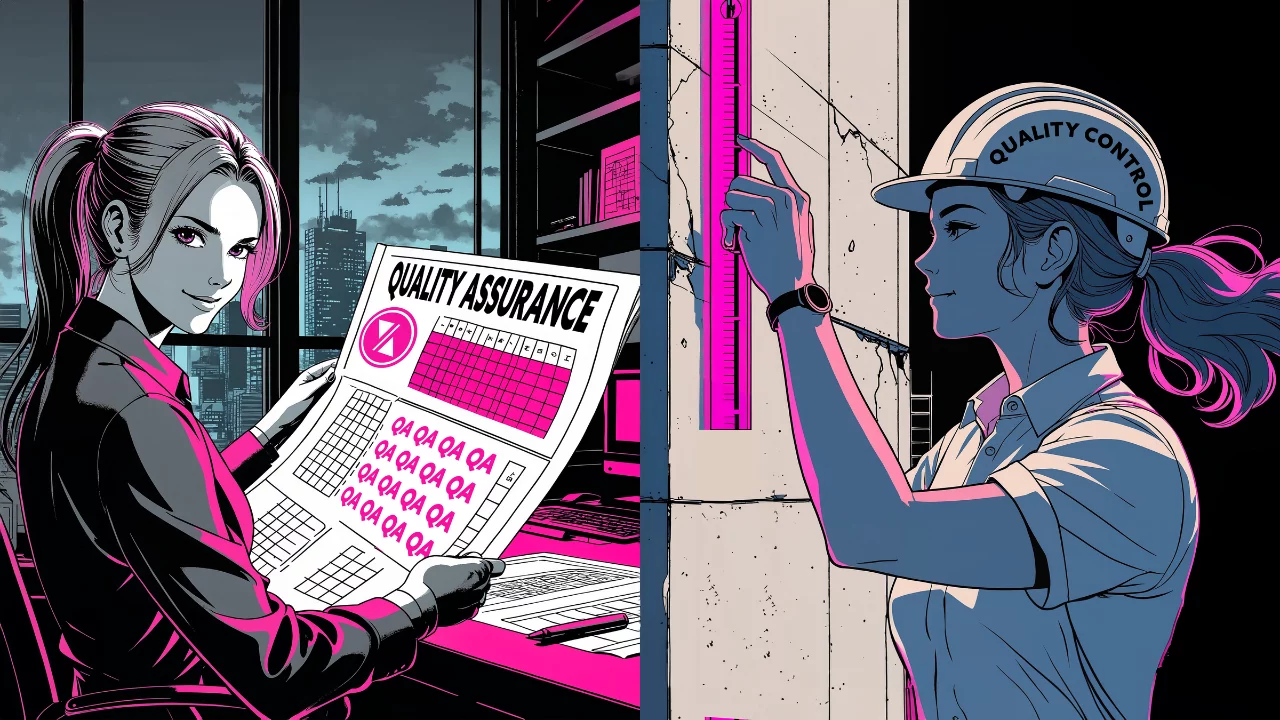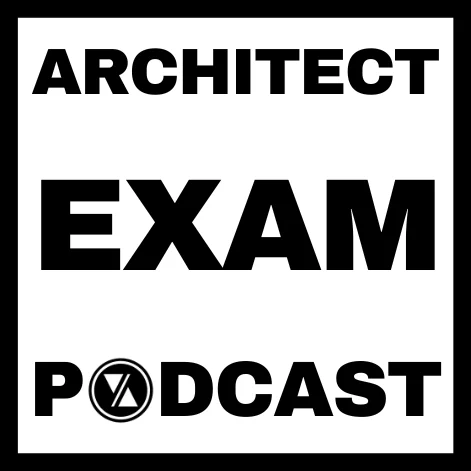Mastering the QA vs QC relationship is crucial for architectural project success. Understanding when to apply quality assurance versus quality control can dramatically reduce errors, improve workflow efficiency, and prevent costly mistakes. This comprehensive guide breaks down the QA/QC meaning, explains their impact across design and construction phases, and provides practical examples to help you identify and implement these quality control procedures in your daily practice.
This podcast is also available on YouTube, Spotify, and Apple Podcasts
The Fundamental Difference: QA vs QC
What is the difference between quality assurance and quality control? Quality Assurance (QA) and Quality Control (QC) are often confused or used interchangeably—which is a mistake that can lead to serious project issues. These distinct processes work together, as a cycle, but serve different purposes in delivering successful architectural projects.
Quality Assurance (QA) refers to the planned and systematic processes that provide confidence a project will satisfy established quality requirements. QA is all about prevention and systems—establishing procedures, standards, and protocols BEFORE problems occur. Define quality assurance as the proactive approach that keeps your project on track from the beginning. Quality assurance activities include establishing standards, training teams, and creating systematic processes based on the desired outcome.
Expectations can change depending on whether the client is public or private, with public projects typically having more formalized QA/QC requirements.
Quality Control (QC), on the other hand, is about monitoring specific results to determine if they comply with quality standards. What is quality control? QC focuses on detection and correction—identifying when something doesn’t meet requirements, and then fixing it. Quality control procedures include inspection and testing of products, materials, and other building components, in order to verify the work meets the established standards and design intent. Which of the following does quality assurance involve? While QA establishes the systems and processes, QC implements the verification steps within that framework.
Here’s an easy way to remember: A comes before C in the alphabet—Quality Assurance (prevention) happens before Quality Control (correction). One happens before and sets the standards; the other happens after and verifies they’re being met.
Everyday Analogies to Understand QA/QC
Let’s make these concepts more relatable with some quality assurance vs quality control examples from everyday life:
Consider cooking a meal:
- QA is following a recipe and measuring ingredients before you start cooking
- QC is tasting the food as you cook and adjusting the seasoning as needed
Imagine you are planning a road trip:
- QA is mapping your route and checking your car beforehand
- QC is monitoring your car gas levels and adjusting your route in case there is traffic during the trip
Maintaining health:
- QA is exercising regularly and following a balanced diet
- QC is monitoring symptoms and treating specific issues that arise
Gardening:
- QA is preparing soil and selecting appropriate plants
- QC is checking for pests and adjusting care based on plant response
In architectural practice, QA and QC form what’s called a “closed loop system”— like a cycle, QA establishes the framework, QC operates within it, and QC results feed back to improve QA procedures. This represents the core of how quality assurance and quality control work together in a complementary process to ensure project success.
QA/QC During the Design Phase
Many focus only on construction quality and the end result, but effective quality management starts much earlier in the process. Here’s how QA/QC operates early on during design:
Quality Assurance in the Design Phase:
- Establishing design standards and BIM management plans before work begins
- Implementing consistent documentation protocols
- Coordinating regularly with consultants
- Conducting early code analysis and occupancy classification analysis and accessibility compliance checks
- Performing constructability reviews
- Regularly verifying design against the program requirements
Quality Control in Design:
- Conducting structured reviews at each phase milestone (Schematic Design, Design Development, Construction Documents)
- Performing peer reviews or “fresh-eye” reviews
- Verifying technical accuracy (dimensions, cross-references, notes)
- Implementing value engineering to ensure budget compliance
- Documenting milestone approvals and sign-offs
The key difference is that QA in design establishes the ongoing standards and processes that guide the design work throughout the process, while QC in design involves formal, documented evaluations at specific points.
A real-world example: A firm I worked with implemented a robust QA program requiring three-person review teams for all projects over a certain size. Each team included someone from outside the project team for a fresh perspective. While this initially seemed time-consuming, it reduced errors by over 40% and actually accelerated project delivery by minimizing rework later. By having a preset plan, followed by reviews and checks, time was well spent up front, rather than scrambling to fix an issue later.
QA/QC in Construction Documentation
As design transitions to construction documents, quality processes become even more critical. This is where your documents must clearly communicate design intent and technical requirements to builders.
Quality Assurance in Documentation:
- Establishing document standards (drawing standards, sheet organization, notation)
- Coordinating technical specifications
- Conducting regular interdisciplinary coordination
- Sequencing drawing production efficiently
- Understanding different construction specification types is essential for effective quality management in documentation
- Learning to avoid specification mistakes that commonly plague architectural documentation
Quality Control in Documentation:
- Verifying technical accuracy (dimensions, coordination between plans/sections/elevations)
- Ensuring complete scope coverage with no missing information
- Checking interdisciplinary coordination (structural/architectural, MEP/architectural)
- Conducting final document review before issuance
The consequences of documentation QA/QC failures can be severe. On one high-profile project, insufficient coordination between structural and architectural drawings resulted in a concrete beam that interfered with a main corridor’s clearance requirements. The error was caught during construction, resulting in costly redesign, schedule delays, and damaged client relationships—all preventable with proper documentation QA/QC.
QA/QC During Construction Administration
Once construction begins, QA/QC transitions from documents to the physical building.
Quality Assurance in Construction:
- Conducting pre-construction meetings to review quality expectations
- Establishing submittal review procedures for verifying proposed materials and systems
- Creating systems for RFI management and documentation
- Developing site visit protocols
- Implementing non-conformance documentation processes
- Setting up processes for managing construction change orders when quality issues require modifications
Quality Control in Construction:
- Planning testing and inspection schedules
- Verifying materials match approved submittals
- Inspecting first installations of critical systems
- Continuously verifying conformance to requirements
- Managing project closeout quality verification (punch lists, systems testing)
Roles and Responsibilities in QA/QC
Understanding who’s responsible for what is crucial for effective quality management:
The Architect/Engineer:
- Establishes quality standards in contract documents
- Implements design quality assurance and control
- Reviews submittals for conformance
- Conducts field observations
- Has authority to reject non-conforming work
- Important limitations: architects don’t dictate means and methods, and aren’t continuously on site conducting inspections
- Must maintain appropriate professional liability protection to cover quality management responsibilities
The Owner:
- Establishes project quality goals and requirements
- Defines quality expectations in the program
- Engages special inspectors and testing agencies
- May hire a commissioning authority
- Makes decisions on non-conforming work
- Accepts the completed work
The Contractor:
- Responsible for construction means and methods
- Supervises and coordinates work
- Plans and coordinates testing and inspection schedules with construction sequence
- Manages subcontractor quality
- Handles product storage and protection
- Conducts pre-installation meetings
- Verifies installation quality
- Performs self-checks and inspections
- Corrects non-conforming work
- Resolves punch list items
- For larger projects, contractors may be required to secure construction bonds that provide financial protection if quality standards aren’t met.
Real-World Example: Curtain Wall System
Let’s follow a curtain wall system through the entire QA/QC process:
During Design:
- QA: Establish the curtain wall performance requirements based on climate zone, building use, and construction type
- QC: Review integration on the curtain wall with with structural elements and energy performance
In Documentation:
- QA: Develop appropriate details of the curtain wall coordinated with specifications
- QC: Verify details are complete, coordinated, and technically sound
During Procurement:
- QA: Establish submittal review process
- QC: Verify proposed system meets requirements through mock-up reviews and testing
In Construction:
- QA: Conduct pre-installation meetings
- QC: Scrutinize first panel installation, conduct water testing, verify final installation
A breakdown at any stage affects subsequent phases and ultimately building quality. One project I observed had incomplete performance specifications that weren’t caught during document review. This resulted in endless submittal revisions, construction delays, and eventually water infiltration issues that required costly remediation.
QA/QC on the Architecture Registration Exam
Quality assurance and quality control concepts appear across all ARE divisions, but they’re particularly prominent in:
- Practice Management (PcM): Objective 4.2 covers quality management directly, which is extensively covered in our PcM 101 course
- Project Management (PjM): Section 5 addresses quality management in project execution, a key focus in our PjM 101 course
- Construction & Evaluation (CE): Quality verification during construction is thoroughly explained in our CE 101 course
- Project Development & Documentation (PDD): Document quality control
The CDT exam also extensively covers these concepts throughout its content.
Common exam scenarios include questions about who’s responsible for specific QA/QC tasks, when certain processes should occur, and appropriate responses to quality issues. Our ARE 101 courses include numerous practice questions on these topics to help you master these concepts for exam day.
The QA/QC Approach to Exam Success
Interestingly, the ARE itself is a perfect application of QA/QC principles. Many candidates approach the exam through trial and error—essentially a reactive, quality control approach that becomes expensive and frustrating.
Our 10-week intensive ARE Boot Camp applies quality assurance principles to exam preparation—establishing good study habits from the beginning, creating realistic exam schedules, and teaching a proactive learning style directly aligned with NCARB’s objectives. Incorporating multiple learning approaches rather than relying on a single study method is a key quality assurance strategy for exam success. The structured curriculum, personalized attention, comprehensive study materials, and track record of success demonstrate QA principles in action.
Key Takeaways on QA vs QC
- QA and QC are distinct but complementary processes: Quality assurance prevents issues through systems; quality control detects and corrects issues through verification
- The difference between quality control and quality assurance is primarily about timing: QA is preventive while QC is corrective
- QA/QC meaning extends beyond construction—quality management spans the entire project lifecycle, from initial design through construction and closeout
- Each party in the building process has specific QA/QC responsibilities and must understand their role in maintaining quality
- Documentation and communication are essential to effective quality management
- The same QA/QC principles that build better buildings can build better approaches to professional development
Quality isn’t accidental—it’s the result of deliberate systems and verification steps. Understanding what is QA QC and implementing effective quality assurance vs quality control processes will not only help you pass your exams but will make you a more effective architect throughout your career.
If you’re studying for the ARE or CDT exams and need resources on QA vs QC and quality management, our comprehensive ARE 101 course membership and CDT 101 certification preparation course provide extensive coverage of quality assurance vs quality control with practice questions designed to help you master these concepts for exam success.



